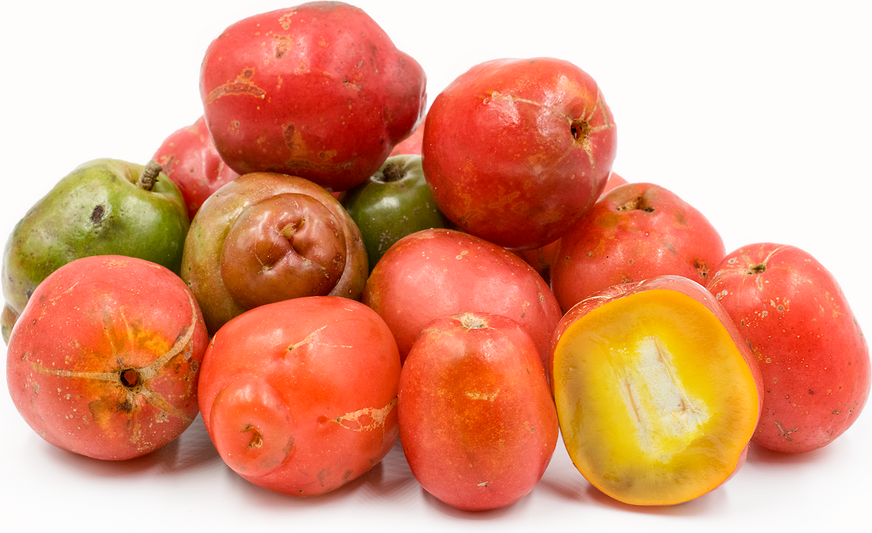


Jocote
Estimated Inventory, lb : 0
This item was last sold on : 05/06/25
Description/Taste
Jocote is a small, oval-shaped fruit that grows on tropical deciduous trees. It flourishes along robust, gnarled branches in clusters or as solitary fruits. Characterized by its slightly elongated teardrop shape, Jocote spans 2.5 to 5 centimeters in diameter. Young Jocote fruits have a yellowish-green hue, maturing into either purple, red, or yellow. Its thin, waxy skin can display light brown speckles as it experiences natural wear and tear. Jocote’s texture is smooth yet firm to the touch. The flesh starts as a vivid light green and gradually deepens to rich shades of yellow and orange as it ripens. Within the flesh is a large, inedible seed taking up about 60 to 70% of the fruit's volume. Jocote emits a subtly sweet and fruity fragrance reminiscent of tropical fruits like mango and apricot. The taste of Jocote reaches its peak sweetness when fully ripe, though its unripe state is notably sour. Its flavor profile is often compared to a plum, featuring a sweet essence with a tart, Granny Smith apple-like finish. Its taste resembles mango pudding, blending sweetness with a citrusy undertone.
Seasons/Availability
Jocote fruit is available from July to October.
Current Facts
Jocote fruit is scientifically classified as Spondias purpurea, belonging to the cashew family. It’s recognized by various names such as Purple Mombin, Jamaica Plum, Chili Plum, and Great Hog Plum. Jocote is sometimes referred to as "Ciruela" in Spanish, which translates to "Plum,” though Jocote is unrelated to the Plum's genus or family. The fruit displays remarkable diversity in terms of color and appearance, particularly in Nicaragua, where there are as many as 50 varieties. The Jocote tree is valued not only for its fruit but also for its medicinal properties, which have been long appreciated by Mesoamerican indigenous populations.
Nutritional Value
Jocote fruit is recognized for its significant vitamin C and carbohydrate content, along with a notable level of vitamin A, which exceeds the amount found in cashews and guavas. Jocote is a valuable source of essential minerals like calcium and phosphorus, vital for maintaining bone health and facilitating metabolism. Jocote contains carotene, B-complex vitamins, amino acids, and antioxidants, which can protect the body against oxidative stress. The considerable carbohydrate and iron levels make it a good energy source, enhancing physical endurance and cognitive performance. In traditional Mexican medicine, Jocote has been utilized for its diuretic and antispasmodic properties, contributing to the treatment of various health issues by increasing urine output and alleviating muscle spasms. A decoction of the fruit may be applied topically to heal wounds and treat mouth sores. The leaves of the tree are known for their antimicrobial properties, and the leaf juice is traditionally consumed to alleviate swollen glands. When mixed with sapote or pineapple, the sap from Jocote trees has been used to treat jaundice. Various parts of the plant, including the bark, are utilized in traditional remedies for dysentery, diarrhea, headaches, and sore throats.
Applications
Jocote can be eaten raw or cooked. Ripe Jocote is eaten similarly to plums or mangoes, where the sweet pulp is consumed, and the stone is discarded. The whole fruit can be boiled in water with sugar to produce a syrup or "honey" that complements ice cream. Jocote can be cooked into jams, macerated in rum to make alcoholic punches, transformed into a tart sauce, or pickled with vinegar, chili peppers, and salt. Jocote pairs well with ingredients such as citrus and tropical fruits, chili, nutmeg, and herbs like mint, cilantro, and basil. It also complements the flavors of meats, seafood, and various cheeses, including mozzarella and bleu cheese. Jocote fruit can be stored in the refrigerator for up to one week. By boiling and drying Jocote fruits, they can be preserved for several months.
Ethnic/Cultural Info
For centuries, the people of Latin America have utilized Jocote for its culinary and medicinal properties. In Costa Rica, unripe green Jocotes are eaten with a sprinkle of salt. In Mexico, they are turned into chamoy sauce or pickled in vinegar, then consumed with salt and chili peppers. In Nicaragua, they make Almibar, a dessert featuring Jocote alongside papaya, mangoes, currants, peppercorns, and cinnamon, commonly served on Easter. Beyond their edible uses, Jocote trees play a crucial role in agricultural practices, often employed to create living fences and combat soil erosion.
Geography/History
Jocote fruits originate from a region extending from southern Mexico to northern Peru, including parts of north-coastal Brazil, and are particularly prevalent in Costa Rica, Guatemala, Honduras, El Salvador, and Panama. The fruit has established a presence in the West Indies, the Bahamas, and parts of Southeast Asia, including Laos, Indonesia, Malaysia, the Philippines, Thailand, and Papua New Guinea. Adapted to tropical climates and preferring shallow, loamy soils, Jocote is cultivated in home gardens, grows naturally in the wild, and is farmed commercially throughout the American tropics. The introduction of Jocote to the Philippines by Spanish explorers as part of the Columbian Exchange led to its integration into the Filipino culinary landscape. The popularity of Jocote and its successful cultivation have been crucial in counteracting the potential risk of endangerment due to the diminishing acreage of tropical dry forests in Central America. Jocote fruits are available in specialty stores that feature Central American cuisine and products.
Recipe Ideas
Recipes that include Jocote. One
| Recetas de Argentina |
|
Jocote Honey |
| Mexico In My Kitchen |
|
Aqua de Ciruela |




